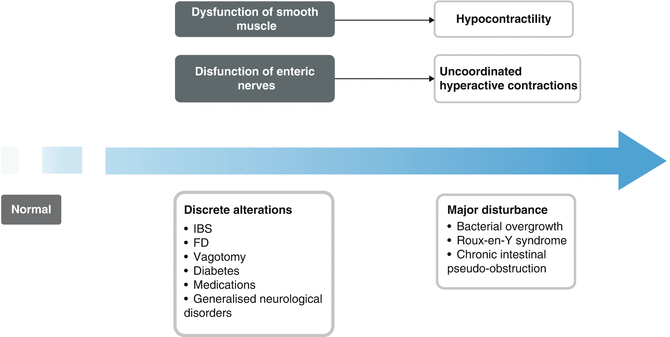, André Smout1 and Jan Tack2
(1)
Gastroenterology and Hepatology, Academic Medical Centre, Amsterdam, The Netherlands
(2)
Gastroenterology and Hepatology, UZ Leuven, Leuven, Belgium
6.1 Small Bowel Motility
During fasting, the stomach and small bowel exhibit a recurrent pattern of contractions and quiescence, which is called the migrating motor complex (MMC). A full MMC cycle lasts 90–120 min and comprises three phases (see Chap. 1). Phase 1 is a period of absence of contractions; during phase II contractions occur with highly variable frequency without apparent rigorous organization. Phase III is characterized by a period of 5–12 min of strong contractions at maximum frequency (3/min in the stomach, up to 12/min in the small intestine), followed again by phase I. This pattern starts proximally, in the stomach or the duodenum, and gradually moves aborally to the distal small bowel, to start again proximally. During the passage of phase III, nonabsorbable remnants are cleared from the antrum, and intestinal phase III ensures further evacuation of small bowel content into the large intestine. This activity is referred to as the intestinal housekeeper function of the MMC.
Upon food ingestion, small bowel motility switches to a so-called postprandial motor pattern. In this phase, apparently random contractile activity occurs throughout the small intestine. However, the composition of the meal and its fiber content and viscosity have all been shown to influence the type of contractions. The control of postprandial motility is very poorly understood and understudied.
6.2 Disorders of Small Bowel Motility
The small bowel is the largest segment of the gastrointestinal tract but is less frequently studied. Disorders of small bowel motility are part of a spectrum (Fig. 6.1). In frequently occurring conditions, such as functional dyspepsia or the irritable bowel syndrome, subtle abnormalities in small bowel motility, with uncertain pathophysiological significance, can be observed. Severe disorders, such as chronic intestinal pseudo-obstruction, are rare (Table 6.1).


Fig. 6.1
Spectrum of disorders of small bowel motility
Table 6.1
Motility disorders of the small intestine
Acute |
Infectious gastroenteritis |
Paralytic ileus as a complication of: |
Ketoacidosis |
Hypokalemia |
Peritonitis |
Postoperative state |
Chronic |
Functional dyspepsia |
Irritable bowel syndrome |
Hyperthyroidism |
Pseudo-obstruction: |
As part of chronic idiopathic intestinal pseudo-obstruction (CIIP) |
Secondary to diabetes, scleroderma < div class='tao-gold-member'>
Only gold members can continue reading. Log In or Register to continue
Stay updated, free articles. Join our Telegram channel
Full access? Get Clinical Tree
 Get Clinical Tree app for offline access
Get Clinical Tree app for offline access

|





